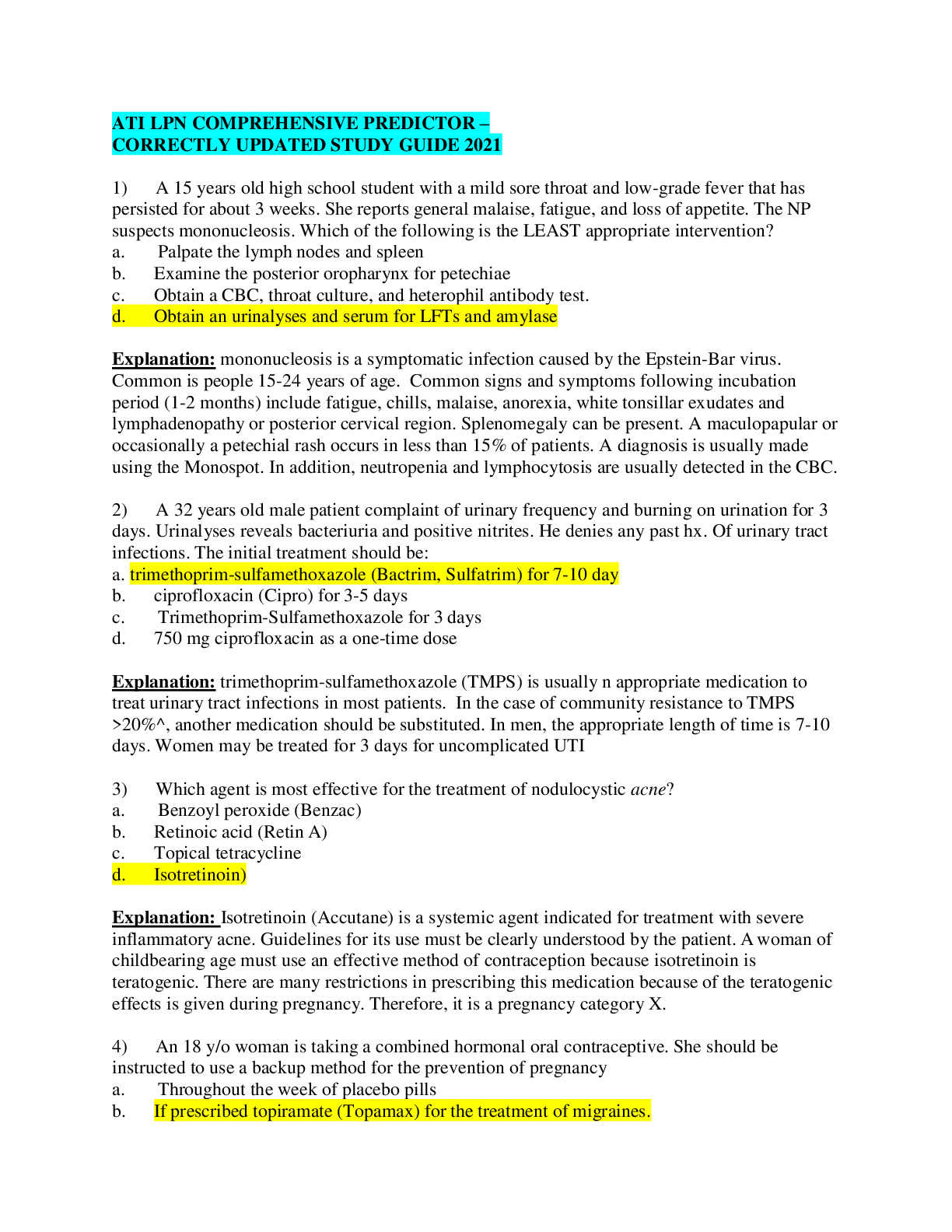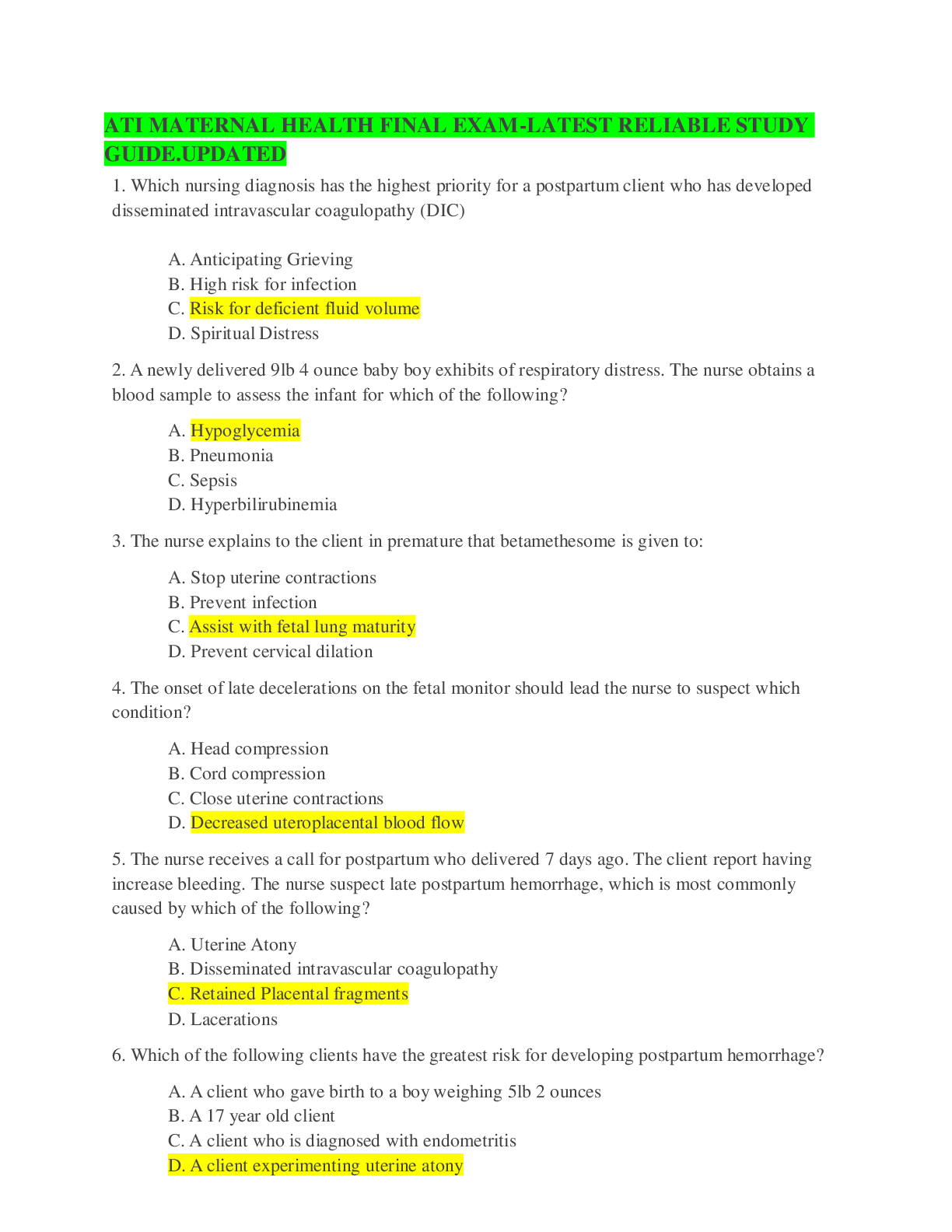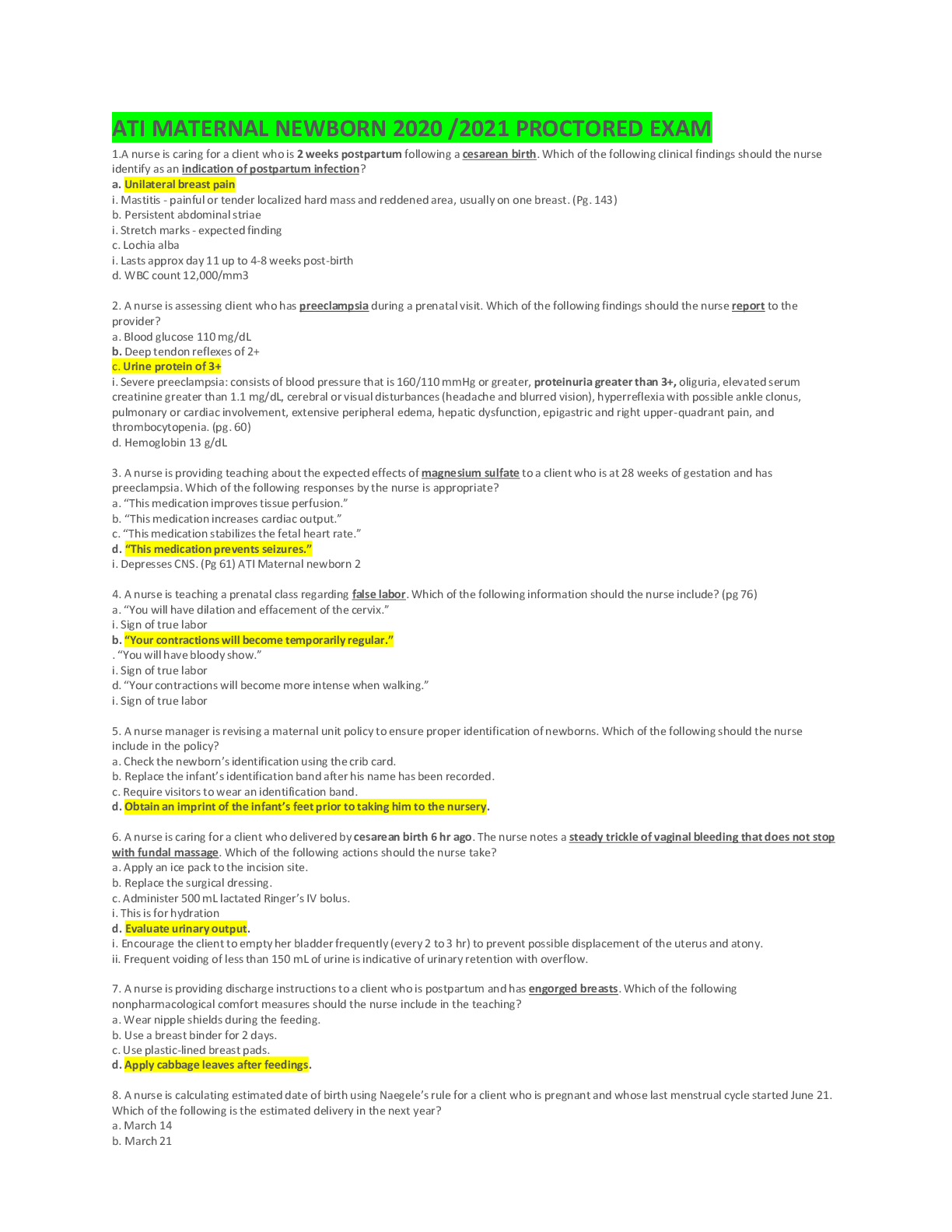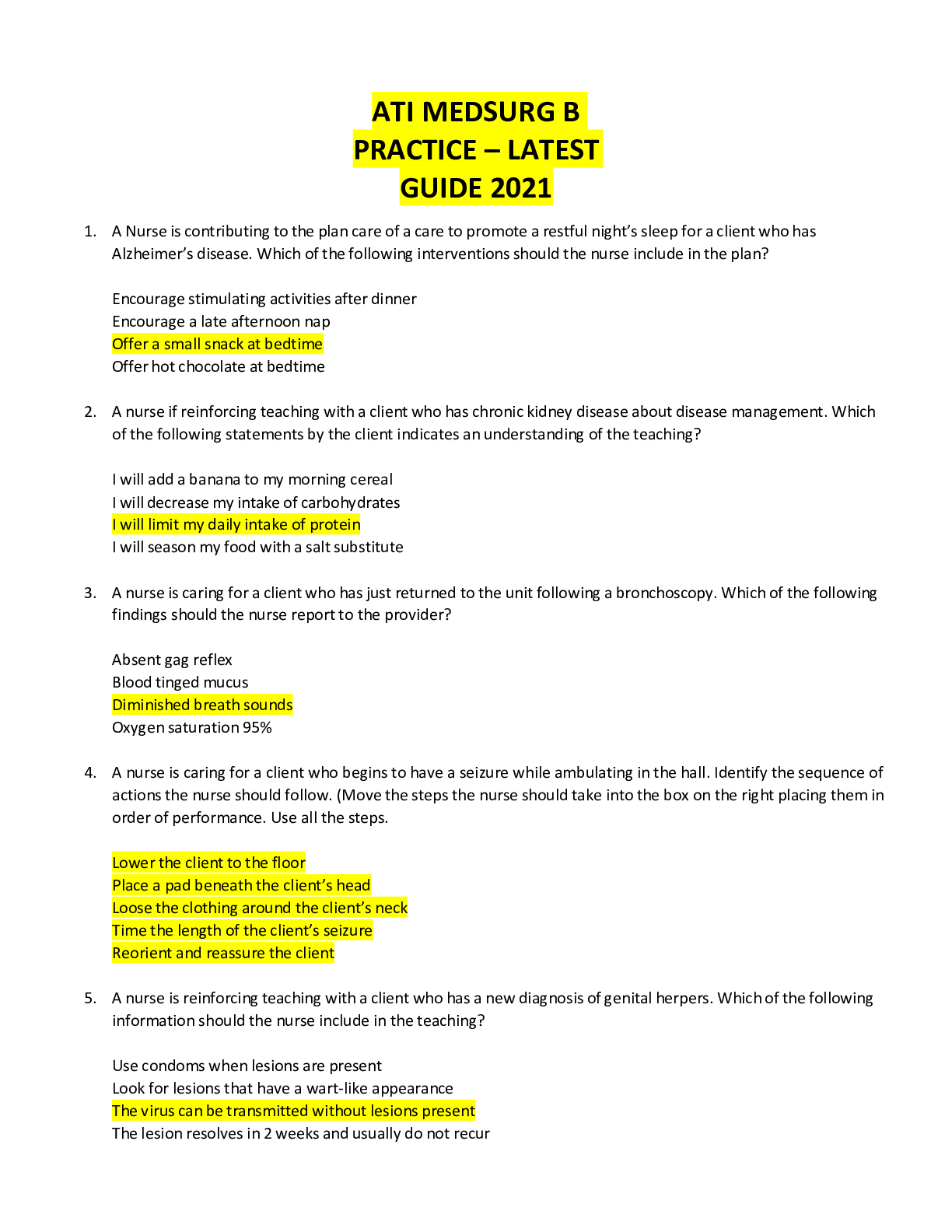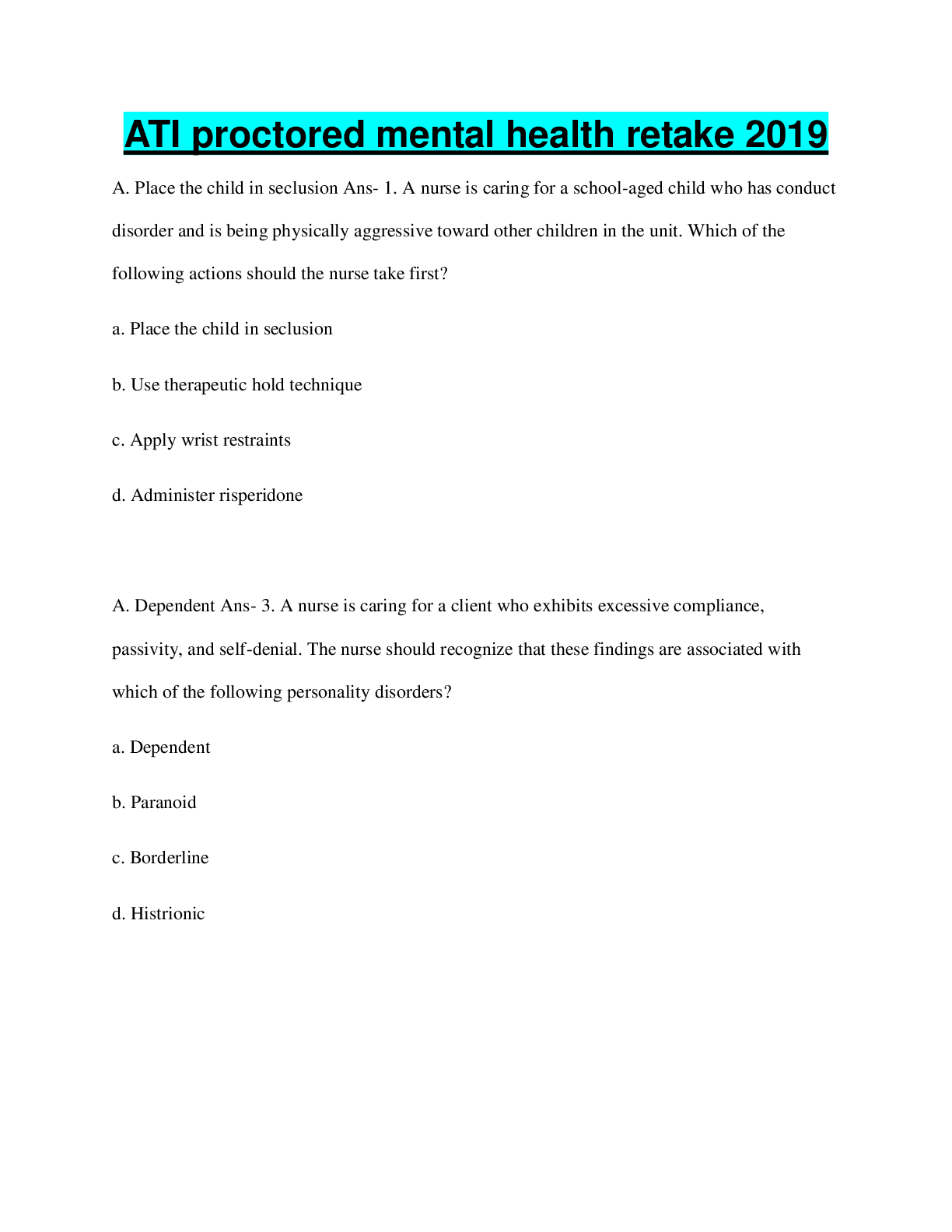*NURSING > QUESTIONS & ANSWERS > ATI MENTAL HEALTH RETAKE EXAM- LATEST GUIDE (All)
ATI MENTAL HEALTH RETAKE EXAM- LATEST GUIDE
Document Content and Description Below
1. What are the phases of the cycle of violence that can occur between domestic partners and what may take place during each of these phases? -Tension-building phase: The abuser has minor episodes of... anger and can be verbally abusive and responsible for some minor physical violence. The vulnerable person is tense during this stage and tends to accept the blame for what is happening. -Acute battering phase: The tension becomes too much to bear, and serious abuse takes place. The vulnerable person can try to cover up the injury or try to get help. -Honeymoon phase: The situation is defused for a while after a violent episode. The abuser becomes loving, promises to change, and is sorry for the behavior. The vulnerable person wants to believe this and hopes for change. Eventually the cycle begins again. -Period of escalation and de-escalation usually continue with shorter and shorter periods of time between the two. Emotions for the abuser and vulnerable person (fear, anger) increase in intensity. Repeated episodes of violence lead to feelings of powerlessness. 2. A nurse is caring for a client hospitalized for opioid dependency. What manifestations should the nurse anticipate when abstinence syndrome begins? -Withdrawal manifestations are not life threatening, but suicidal ideation can occur. -Common findings include agitation, insomnia, flu-like manifestations, rhinorrhea, yawning, sweating and diarrhea. 3. The nurse is reviewing the admission information on a client being admitted with schizophrenia. The provider has indicated that the client has ‘schizophrenia with negative symptoms’. What would the nurse expect to notice in this client? How do negative symptoms differ from the positive symptoms of schizophrenia? -In a client that has schizophrenia with negative symptoms the nurse would expect to notice social withdrawal, lack of emotion, lack of energy, flattened affect, decreased motivation, and or decreased pleasure in activities. -In a client that has schizophrenia with positive symptoms are related to behavior thought, perception, and speech such as agitation, bizarre behavior, delusions, hallucinations, flight of ideas and or loose associations. 4. A nurse is caring for a client with a binge eating disorder. 1) What is binge-eating disorder? 2) What disorders is this client at increased risk for because of the weight gain associated with binge eating? -Binge eating disorder: Clients recurrently eat large quantities of food over a short period of time without the use of compensatory behaviors associated with bulimia nervosa. Excessive food consumption must be accompanied by a sense of lack of control at least once per week for 3 months. -The weight gain associated with binge eating disorder increases the client’s risk for other disorders, including type to diabetes mellitus, hypertension and cancer. 5. A nurse is reinforcing client education about the risk of hepatotoxicity with the drug valproic acid. What information should be included? -Determine baseline liver function, and monitor function regularly (minimum of every 2 months during the first 6 months of treatment) -Advise the client to observe for indications of hepatoxicity (nausea, dark colored urine, fever, loss of appetite, jaundice, fatigue) and to notify provider immediately if they occur. -Avoid in using in children younger than 2 years old. -Administer the lowest effective dose. 6. A client has been prescribed imipramine hydrochloride. What are some important aspects of teaching the nurse should reinforce before discharge? -Avoid concurrent use of tricyclic antidepressants (TCAs) and monoamine oxidase inhibitors (MAOIs) -Advise the client to avoid taking with other CNS depressants. -Practice good nutrition and exercise to decrease risk of weight gain. -Avoid hazardous activities, such as driving if sedation is excessive. -Take medication at bedtime to minimize daytime sleepiness and to promote sleep. Taking the medication at bedtime minimizes experiencing adverse effects during the day. -Change positions slowly to prevent orthostatic hypotension. Avoid dehydration, which increases risk for hypotension. 7. A client has been prescribed clonazepam. What is the likely reason this medication was prescribed and what lab values should be monitored by the nurse? -The likely reason this medication is prescribed is relief from anxiety. It is a first-line treatment for generalized anxiety disorder and panic disorder. -lab values that should be monitored are serum sodium, liver and kidney tests 8. A client has been prescribe Varenicline. What are some adverse effects the nurse should monitor for? -Neuropsychiatric effects (unpredictable behavior, mood changes, thoughts of suicide) -nausea -vomiting -insomnia -new onset depression -suicidal thoughts 9. A nurse is caring for a client who is taking haloperidol. The client has developed signs of infection. What potential complication may be occurring and what nursing actions should be taken related to the possibility of infection? -Agranulocytosis may be occurring -Advise for clients to observe for indications of infection (fever, sore throat, malaise) and to notify the provider if these flu-like manifestations occur -Nurse should obtain a CBC for client -Medication should be discontinued if laboratory test indicates the presence of an infection. 10. A client has been prescribed sertraline for generalized anxiety disorder. The nurse asks the client if he has any further questions after having spoken to the nurse and provider. The client states “Well, I really don’t understand why I am on this medication since I am not depressed.” How should the nurse reply? -SSRI antidepressants are the first line treatment for panic disorders and trauma and stressor related disorders. -SSRIs do not block uptake of dopamine or norepinephrine -Sertraline is indicated for social anxiety disorder, PTSD, OCD, and panic disorder 11. A nurse is caring for a client with bipolar disorder who has been prescribed lithium carbonate. Identify five (5) potential adverse effects of this medication therapy. What nursing interventions and teaching points should the nurse reinforce regarding the medication therapy to prevent and address these associated adverse effects? -adverse effects: gastrointestinal distress, fine hand tremors, polyuria, mild thirst, weight gain, kidney toxicity,bradydysrhythmias, hypotension and electrolyte imbalances -Administer medication with meals or milk -Adjust dosage to be as low as possible; give in divided doses; or use long acting formulations -Use potassium sparing diuretic, such as spironolactone -Assist the client to follow a healthy diet and regular exercise regimen -Monitor I and O -Maintain adequate fluid and sodium intake -Instruct client to monitor for indications of toxicity and when to contact the provider. The client should withhold medication and seek medical attention for diarrhea, vomiting or excessive sweating 12. A client has been prescribed Sertraline. What findings should the nurse immediately report to the RN or provider? -serotonin syndrome : agitation, confusion, disorientation, difficulty concentrating, anxiety, hallucinations, hyperreflexia, fever, diaphoresis, incoordination and tremors. Usually begins 2-72 hours after initiation of treatment -bruxism: grinding and clenching of teeth, usually during sleep. 13. A client has been taking Escitalopram for 3 days. The family calls the clinic and reports that the client is agitated, confused and has a fever. How should the nurse respond? -tell family to withhold the medication and notify provider immediately 14. Systematic desensitization is a type of behavioral therapy that is often used to treat anxiety disorders. What is systemic desensitization and how is it used in nursing practice? -Systematic desensitization begins with mastering relaxation techniques. Then, a client is exposed increasing levels of an anxiety producing stimulus (either imagined or real) and uses relaxation to overcome the resulting anxiety. The goal of therapy is that the client is able to tolerate a greater and greater level of the stimulus until anxiety no longer interferes with functioning. This form of therapy his especially effective for clients who have phobias ..............................................................................................................................................................................................................................CONTINUED [Show More]
Last updated: 1 year ago
Preview 1 out of 4 pages
Instant download
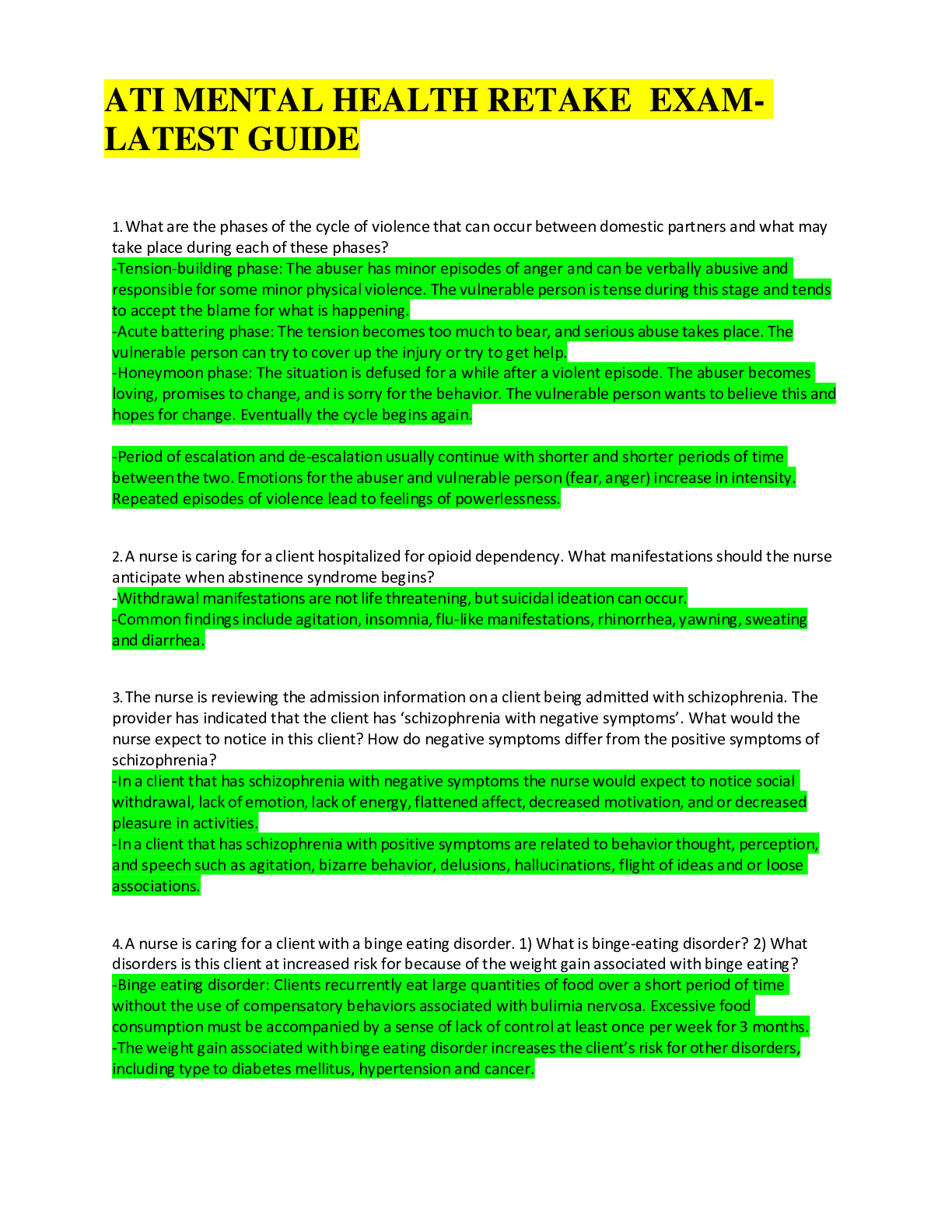
Buy this document to get the full access instantly
Instant Download Access after purchase
Add to cartInstant download
Reviews( 0 )
Document information
Connected school, study & course
About the document
Uploaded On
Nov 20, 2021
Number of pages
4
Written in
Additional information
This document has been written for:
Uploaded
Nov 20, 2021
Downloads
0
Views
89


